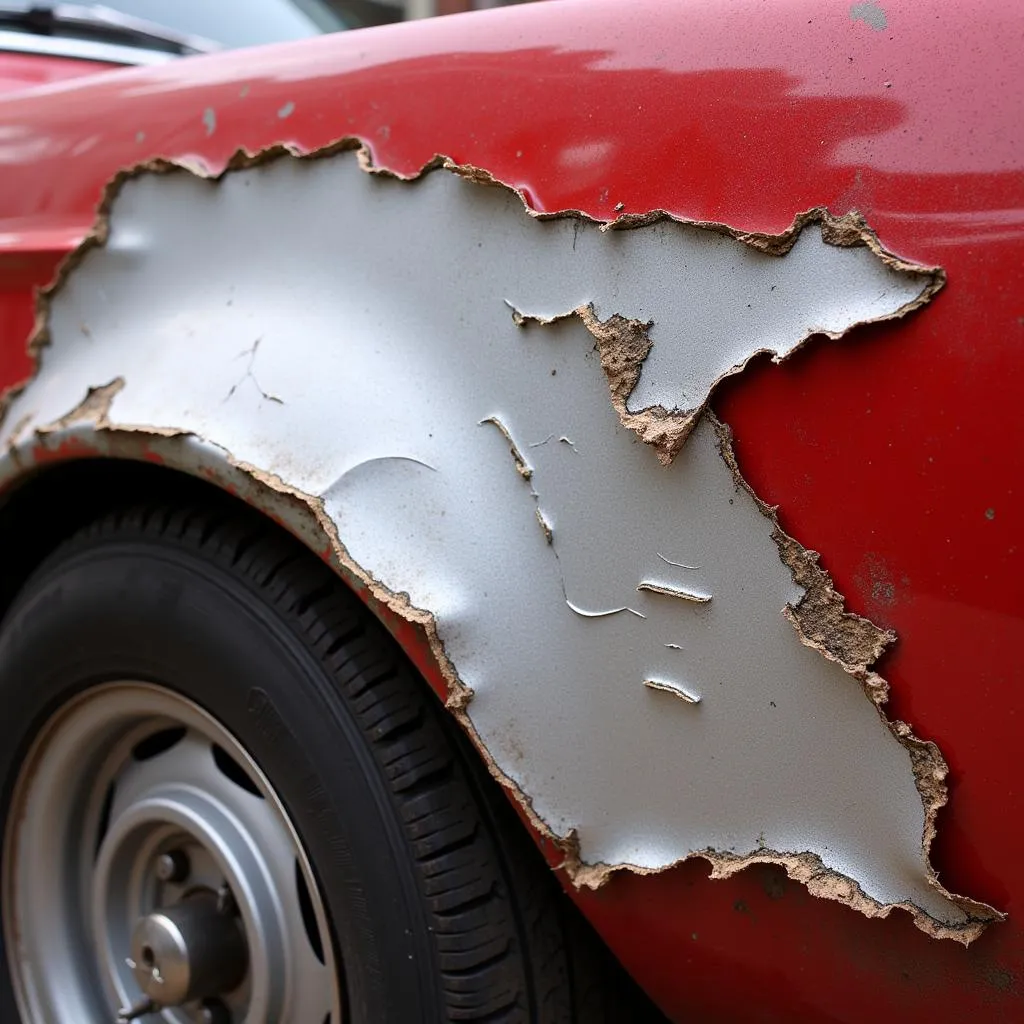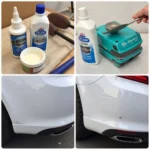Car paint lacquer peeling is a common problem that can make your vehicle look old and worn. It occurs when the clear coat, which is the top layer of paint that protects your car from the elements, starts to deteriorate. This can happen for a number of reasons, including exposure to UV rays, acid rain, bird droppings, and even extreme temperatures.
Understanding Car Paint Layers
Before delving into the repair process, it’s crucial to understand the different layers of car paint. This knowledge will help you grasp the importance of each layer and the complexities of lacquer peeling repair.
- Primer: The foundation layer applied to the bare metal, providing corrosion resistance and a smooth surface for subsequent coats.
- Base Coat: The layer responsible for your car’s color, providing pigmentation and aesthetic appeal.
- Clear Coat: Also known as lacquer, this transparent top layer provides protection from UV rays, scratches, and environmental contaminants. It also enhances the base coat’s gloss and depth of color.
When the clear coat, or lacquer, begins to peel, it exposes the base coat to the elements, making it vulnerable to further damage.
Common Causes of Car Paint Lacquer Peeling
Identifying the root cause of your car’s peeling paint is essential for effective repair and prevention of future occurrences. Here are some of the most common culprits:
- UV Radiation: Prolonged exposure to the sun’s harmful UV rays is a primary cause of lacquer breakdown, causing it to become brittle and peel over time.
- Environmental Factors: Acid rain, bird droppings, tree sap, and industrial fallout contain chemicals that can eat away at the clear coat, compromising its integrity.
- Improper Washing Techniques: Using harsh detergents, abrasive materials, or neglecting to wash your car regularly can contribute to lacquer deterioration.
- Poor Quality Paint Job: Using low-quality paint or improper application techniques during a previous repair can lead to premature peeling.
Signs of Car Paint Lacquer Peeling
Early detection is key to preventing further damage and minimizing repair costs. Keep an eye out for these telltale signs:
- Clear Coat Flaking: Noticeable flakes or chips in the clear coat, revealing the base coat underneath.
- Loss of Shine: A dull or faded appearance in certain areas, indicating a compromised clear coat.
- Cracking or Spider Webbing: Fine cracks or a spiderweb-like pattern appearing on the paint surface, signaling clear coat deterioration.
- Rough Texture: The once smooth paint surface feels rough or uneven to the touch, a sign of advanced lacquer damage.
Can You Repair Peeling Car Paint Lacquer Yourself?
While minor peeling can sometimes be addressed with DIY methods, it’s essential to approach the repair with caution and realistic expectations.
For small, localized areas of peeling, you can try using a rubbing compound or polishing compound to smooth out the edges and blend the damaged area with the surrounding paint. However, this is only a temporary fix and will not address the underlying issue of a deteriorating clear coat.
For more extensive peeling or if you’re not confident in your DIY skills, it’s best to seek professional help. A qualified auto body shop has the experience, tools, and expertise to assess the damage, recommend the best course of action, and ensure a lasting repair.
Professional Car Paint Lacquer Peeling Repair
Professional repair typically involves the following steps:
- Assessment: A thorough inspection to determine the extent of the damage and identify the underlying cause.
- Surface Preparation: The affected area is cleaned, sanded, and feathered to create a smooth transition for the new paint.
- Priming (If Necessary): If the peeling has exposed the base coat or metal, a primer is applied to provide a suitable surface for painting.
- Base Coat Application: The base coat is matched to the existing paint color and applied to the repaired area.
- Clear Coat Application: Multiple layers of clear coat are applied to protect the base coat and restore the shine.
- Color Sanding and Buffing: The repaired area is meticulously sanded and buffed to achieve a seamless blend with the surrounding paint and restore a factory-like finish.
Preventing Car Paint Lacquer Peeling
Preventing lacquer peeling is always more cost-effective than repair. Follow these preventive measures to safeguard your car’s paint:
- Regular Washing and Waxing: Wash your car regularly with a pH-neutral car wash soap and apply a high-quality car wax every few months to create a protective barrier against the elements.
- Park in the Shade: Whenever possible, park your car in a garage or under a shaded area to minimize UV exposure.
- Address Bird Droppings and Tree Sap Promptly: These substances contain acidic properties that can damage the clear coat, so it’s essential to remove them as soon as possible.
- Use a Car Cover: If you don’t have access to covered parking, consider using a car cover, especially during extended periods of non-use.
- Consider Paint Protection Film: For added protection, consider investing in paint protection film, a transparent polyurethane film applied to vulnerable areas like the hood, bumpers, and mirrors to shield them from scratches, chips, and UV rays.
Conclusion
Car paint lacquer peeling, while a common issue, can be addressed effectively with the right approach. By understanding the causes, recognizing the signs, and taking proactive measures, you can maintain your car’s paint job and keep it looking its best for years to come.
Remember, for minor peeling, DIY solutions might suffice, but for significant damage or if you’re unsure, always consult with a qualified auto body professional for a long-lasting and professional repair.



